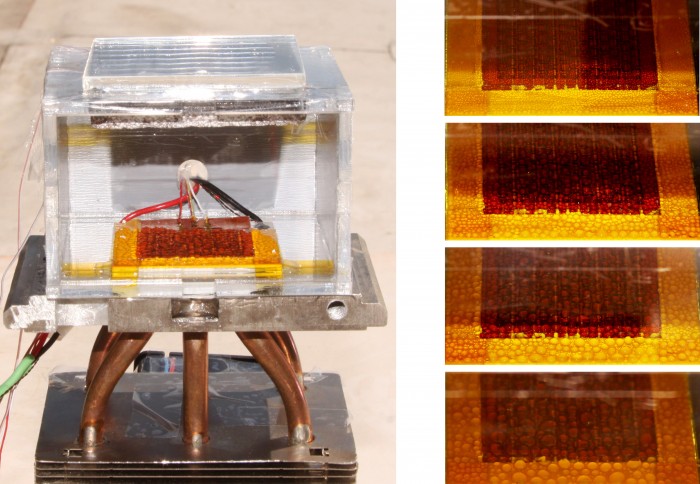How To Make Water Out Of Thin Air
Scientists take developed a device that tin can suck water out of desert skies, powered by sunlight alone. They promise that a version of the technology could somewhen supply clean drinking water in some of the driest and poorest parts of the earth.
The device is based on a novel fabric that can pull large amounts of water into its many pores. According to a study published in the journal Science on Thursday, a kilogram of the material can capture several liters of water each twenty-four hours in humidity levels as low as 20 percent, typical of arid regions.
The technology could aid address a big and growing trouble. A written report concluding twelvemonth in Science Advances establish that four billion people, nearly half in India and People's republic of china, face "severe water scarcity at least one month of the year." That means h2o shortages affect two-thirds of the globe'southward population. These shortages—and the resulting conflicts—are just expected to become more than common in large parts of the world as climate change accelerates.
A team at MIT adult the technology with Omar Yaghi's laboratory at the University of California, Berkeley. The key component is a promising form of synthetic porous materials called metal-organic frameworks, composed of organic molecules stitched together with metallic atoms, which Yaghi pioneered (run across "A Improve Fashion to Capture Carbon"). The size and chemical character of the material's pores tin exist customized to capture item types of molecules or allow them to flow through. The fabric also has a massive expanse, on the order of a football field per gram, enabling it to bond with a large quantity of particles.

In this instance, the scientists employed a previously developed version of the fabric that Yaghi optimized to efficiently capture water molecules. The epitome bonds with water at night or in shade. But during the twenty-four hour period, sunlight hitting the material adds plenty energy to catechumen the water molecules into vapor. In turn, they skid out of the material's pores and into an next acrylic enclosure. A condenser at the lesser of the vessel collects the water droplets and funnels them into a chamber below, from which clean water can be collected.
The procedure is completely passive, with no demand for solar panels, batteries, or additional energy. Previous h2o-harvesting technologies have been limited to areas with fog or other high-moisture conditions.
Though they plan to go on refining the engineering science, they're "not that far away" from a viable product, says Evelyn Wang, head of MIT's device research laboratory. She notes that materials of this blazon are already being mass-produced, at increasingly affordable prices, by the German chemical behemothic BASF.
Yaghi says the technology could be paired with solar panels or other equipment to heave water production for industrial or agricultural purposes. Just the large hope, he says, is that these devices could go household fixtures in poorer parts of the globe. That would permit families to reliably produce their own water instead of rationing whatever they can comport, or whatever is available, from customs wells.
How To Make Water Out Of Thin Air,
Source: https://www.technologyreview.com/2017/04/13/152575/water-from-desert-skies/
Posted by: davisonated.blogspot.com


0 Response to "How To Make Water Out Of Thin Air"
Post a Comment